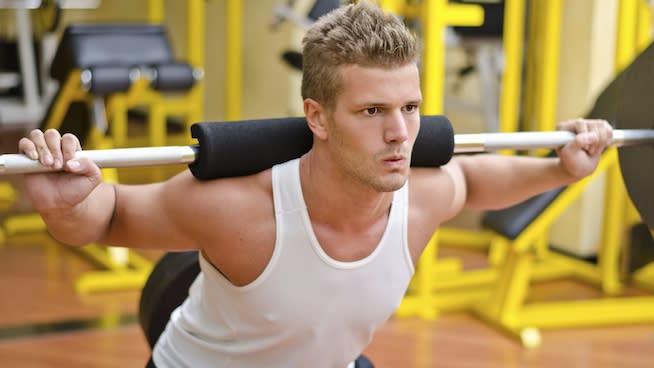Squat Exercise Modifications to Train Around an Injury

A common mantra in the strength and conditioning field is "do no harm." As a coach, I constantly come across clients and athletes who have either acute or chronic injuries, but still attempt to squat as they would with no injuries.
The Squat requires mobility at the ankle, hip and thoracic spine with stability at the foot, knee and lumbar spine. It is an incredible exercise for increasing lower-body strength, so it should be a part of most training programs. However, if you have an injury, you need to learn squat modifications to stay safe.
It is my job to make sure my clients and athletes can perform an exercise in a pain-free range of motion. To quote my friend and fellow strength coach, Nick Tumminello:
When it comes to performing the exercises provided in a way that best fits the client, there are two simple criteria:
Since the Squat affects many of the major joints in the body, you may need to change it depending on what acute or chronic injury you have.
Knee Injuries
Squatting with greater forward knee movement increases shear forces at the knee. If you're experiencing knee pain when squatting, check yourself to see if your knees are drifting too far forward. The Box Squat is less stressful on the knees because it is easier to maintain a relatively vertical shin position. This is often a quick fix for people who have knee pain when they squat. If you have menisci damage, deep Squats may also cause a problem. With the Box Squat, the box serves as a depth checker, preventing deep knee flexion.
RELATED: How to Prevent Knee Injuries When Landing and Decelerating
The Front Squat may also be a viable modification for people experiencing knee pain. One study with 15 subjects found the Back Squat produced higher compressive forces on the knee compared to the Front Squat, most likely due to the fact that the athletes used more weight. The authors recommend that, because of the decreased compressive forces and similar muscle activity, the Front Squat may be advantageous for people with knee problems such as ligament and menisci tears.
If you have a history of posterior cruciate ligament (PCL) damage, it may not be best to squat to full depth. Instead, limit your depth to 60 degrees, or two-thirds of a Squat. Also, if you have anterior cruciate ligament (ACL) damage, squat with a slight forward lean of the torso, which engages your hamstrings and shields the ACL from stress.
Lower-Back Pain
Lower-back pain is usually elicited by extension or flexion of the low back. In the case of the Squat, we might see the lower back round. Flexion of the low back could be caused by a number of things, but for the sake of simplicity, let's say it's caused by excessive forward lean during the Squat. This can be changed by switching to the Front Squat. Also, wearing a shoe with a raised heel allows the lifter to stay slightly more upright, reducing low back flexion and subsequent pain. Just do not lift near your max with this type of footwear.
Shoulder Pain
Although the shoulder is not a weight-bearing joint during the Squat, it is placed in a position that could aggravate an existing injury.
For the Barbell Squat, the shoulder is abducted and externally rotated into what is called the "high-five" position, which stresses the anterior capsule of the shoulder and could lead to anterior laxity and eventual instability. For anyone with impingement, labral tear history or anterior instability, this position is not recommended.
Try the Front Squat in this situation, or try squatting with a safety or cambered bar.
Alternatives
There is no rule that says you must squat. If the Squat is causing pain, plenty of alternative exercises effectively train the lower-body musculature. Here are a few options:
Rear-Foot-Elevated Split-Squat: Allows a vertical torso, which spares the back, and a vertical shin position, which spares the knee. Also, the weight can be held at your sides, which spares the shoulders.
Dumbbell Lunge: Another great exercise to train the lower body is the Dumbbell Lunge, which has many of the same benefits as the Rear-Foot-Elevated Split-Squat.
RELATED: How to Workout Through Leg Pain
References
Escamilla, R. F., Fleisig, G. S., Lowry, T. M., Barrentine, S. W., Andrews, J. R. "A three-dimensional biomechanical analysis of the squat during varying stance widths." Journal of the American College of Sports Medicine, 984-998, 2001.
Gullett, J.C., Tillman, M.D., Gutierrez, G.M., Chow, J.W. "A biomechanical comparison of back and front squats in health trained individuals." J Strength Cond Res, 23: 284-292, 2008.
Pabian, P.S., Kolber, M.J., McCarthy, J.P. "Postrehabilitation strength and conditioning of the shoulder: An interdisciplinary approach." Strength Cond J, 33: 42-55, 2011.
Schoenfeld, B. "Squatting kinematics and kinetics and their application to exercise performance." J Strength Cond Res, 3497-3506, 2010.
This article originally appeared on STACK.com: Squat Exercise Modifications to Train Around an Injury

